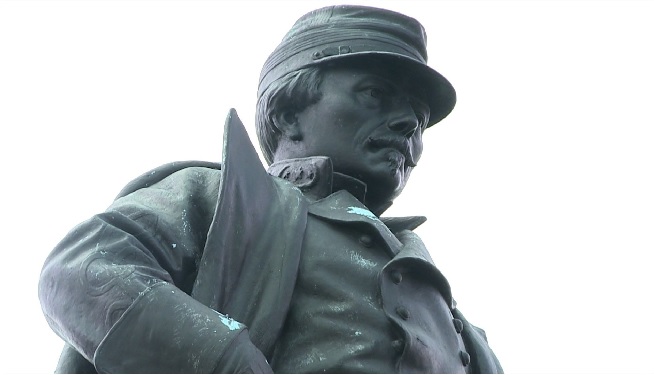NEW ORLEANS — (CNN) The City of New Orleans early Wednesday removed one of the two remaining Confederate monuments that had been scheduled to come down.
The equestrian statue of Confederate Gen. Pierre Gustave Toutant Beauregard honors the military leader who died in New Orleans in 1893. It is the third monument to come down in the city.
Earlier Tuesday, police put up barricades near the monument, CNN affiliate WGNO reported. Protesters both for and against the statue gathered at the site as the work started that evening. Shortly after 3 a.m. Wednesday, crew workers yanked the Beauregard statue from its perch and lowered it to a truck as scattered cheers broke out.
“Today we take another step in defining our city not by our past but by our bright future,” Mayor Mitch Landrieu said in a statement. “While we must honor our history, we will not allow the Confederacy to be put on a pedestal in the heart of New Orleans.”
Three down, one Confederate statue left
Three monuments have been dismantled since the New Orleans City Council in 2015 voted to remove four Confederate landmarks. Recent court decisions paved the way for the city to relocate the monuments after years of heated public debate and legal fights.
A statue of Confederate Gen. Robert E. Lee is the last monument scheduled to be removed and relocated.
Beauregard’s statue, near City Park, was erected in 1915 in honor of the prominent general who led the attack on Fort Sumter in South Carolina, a siege that marked the beginning of the Civil War.
In 2015, the words “Black Lives Matter” were spray-painted on both sides of the monument’s column, CNN affiliate WDAM-TV reported.
Last week, the city removed a 6-foot statue of Confederate President Jefferson Davis from its pedestal. The Davis statue stood atop a roughly 12-foot column and depicted him with his right arm outstretched, towering over the street also named after him.
[van id=”van/batchfeed/2017/05/17/storyful_4c2ea270-3ad1-11e7-8079-1386baa213bf”]
Davis lived in New Orleans after the Civil War and died there in 1889. The statue was dedicated in 1911. In 2004, the words “slave owner” were painted on the monument’s base.
Last month, the city dismantled the first of the four monuments: an obelisk commemorating the Battle of Liberty Place. The monument marked a deadly fight between members of the Crescent City White League, a group opposed to the city’s biracial police force, and state militia after the Civil War.
Amid security threats, contractors wearing masks and tactical vests worked in the dark of night to remove that monument.
Landrieu said the statues will be put in storage while the city looks for a suitable place to display them, such as a museum. The city secured private funding to remove the monuments, the mayor’s office has said.
But backlash has been building against removing Confederate monuments.
The Louisiana House passed a bill Monday that would prohibit local governments from removing war memorials, including those from the Civil War.
House Bill 71 allows local governments to take down a memorial only if voters approve the action at “an election held for that purpose.” The proposal passed in a 65-31 vote and heads to the state’s Senate.
Beyond New Orleans
The effort to remove the New Orleans monuments is part of larger controversy surrounding Confederate symbols in cities nationwide. Some argue the monuments symbolize racial injustice and slavery. Supporters say the monuments are part of history and heritage. The issue rose to prominence after the 2015 massacre of nine black parishioners at the historically black Emanuel African Methodist Episcopal church in Charleston, South Carolina, by a self-described white supremacist.
Efforts to remove Confederate statues are underway in other parts of the South.
In Charlottesville, Virginia, the city council voted narrowly in February to remove a bronze statue of Confederate General Robert E. Lee, and to rename Lee Park, where the statue stands.
That move triggered protests over the weekend, starting with one on Saturday in which torch-carrying demonstrators were led by white nationalist Richard Spencer — evoking swift criticisms that the gathering evoked images of the Ku Klux Klan. A counterprotest was held on Sunday night.
In St. Louis, Missouri, Mayor Lyda Krewson has committed to removing a 32-foot tall Confederate monument from a park. Her spokesman Koran Addo said they’re looking for the right place to house the 40-ton statue before they remove it. The cost could extend over $100,000.
In Orlando, Florida, Mayor Buddy Dyer said he plans to move the marble statue known as “Johnny Reb” from a park to a cemetery. The issue remained contentious during a City Council meeting this week, according to the Orlando Sentinel.
The-CNN-Wire ™ & © 2017 Cable News Network, Inc., a Time Warner Company. All rights reserved. (PHOTO: WGNO-TV via CNN)





















